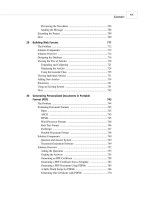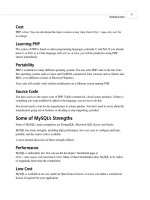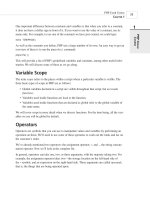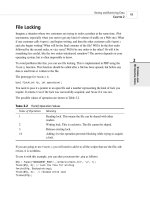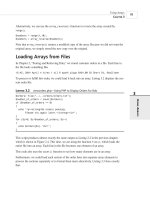Phát triển web với PHP và MySQL - p 10 pot
Bạn đang xem bản rút gọn của tài liệu. Xem và tải ngay bản đầy đủ của tài liệu tại đây (477.41 KB, 10 trang )
File Locking
Imagine a situation where two customers are trying to order a product at the same time. (Not
uncommon, especially when you start to get any kind of volume of traffic on a Web site.) What
if one customer calls fopen() and begins writing, and then the other customer calls fopen()
and also begins writing? What will be the final contents of the file? Will it be the first order
followed by the second order, or vice versa? Will it be one order or the other? Or will it be
something less useful, like the two orders interleaved somehow? The answer depends on your
operating system, but is often impossible to know.
To avoid problems like this, you can use file locking. This is implemented in PHP using the
flock() function. This function should be called after a file has been opened, but before any
data is read from or written to the file.
The prototype for flock() is
bool flock(int fp, int operation);
You need to pass it a pointer to an open file and a number representing the kind of lock you
require. It returns true if the lock was successfully acquired, and false if it was not.
The possible values of operation are shown in Table 2.2.
TABLE 2.2 flock() Operation Values
Value of Operation Meaning
1 Reading lock. This means the file can be shared with other
readers.
2 Writing lock. This is exclusive. The file cannot be shared.
3 Release existing lock.
+4 Adding 4 to the operation prevents blocking while trying to acquire
a lock.
If you are going to use flock(), you will need to add it to all the scripts that use the file; oth-
erwise, it is worthless.
To use it with this example, you can alter processorder.php as follows:
$fp = fopen(“$DOCUMENT_ROOT/ /orders/orders.txt”, “a”, 1);
flock($fp, 2); // lock the file for writing
fwrite($fp, $outputstring);
flock($fp, 3); // release write lock
fclose($fp);
Storing and Retrieving Data
C
HAPTER 2
2
STORING AND
RETRIEVING DATA
65
04 7842 CH02 3/6/01 3:37 PM Page 65
You should also add locks to vieworders.php:
$fp = fopen(“$DOCUMENT_ROOT / /orders/orders.txt”, “r”);
flock($fp, 1); // lock file for reading
// read from the file
flock($fp, 3); // release read lock
fclose($fp);
Our code is now more robust, but still not perfect. What if two scripts tried to acquire a lock at
the same time? This would result in a race condition, where the processes compete for locks
but it is uncertain which will succeed, that could cause more problems. We can do better by
using a DBMS.
Doing It a Better Way: Database Management
Systems
So far all the examples we have looked at use flat files. In the next section of this book we’ll
look at how you can use MySQL, a relational database management system, instead. You
might ask, “Why would I bother?”
Problems with Using Flat Files
There are a number of problems in working with flat files:
• When a file gets large, it can be very slow to work with.
• Searching for a particular record or group of records in a flat file is difficult. If the
records are in order, you can use some kind of binary search in conjunction with a fixed-
width record to search on a key field. If you want to find patterns of information (for
example, you want to find all the customers who live in Smalltown), you would have to
read in each record and check it individually.
• Dealing with concurrent access can become problematic. We have seen how you can lock
files, but this can cause a race condition we discussed earlier. It can also cause a bottle-
neck. With enough traffic on the site, a large group of users may be waiting for the file to
be unlocked before they can place their order. If the wait is too long, people will go else-
where to buy.
• All the file processing we have seen so far deals with a file using sequential processing—
that is, we start from the start of the file and read through to the end. If we want to insert
records into or delete records from the middle of the file (random access), this can be
difficult—you end up reading the whole file into memory, making the changes, and writ-
ing the whole file out again. With a large data file, this becomes a significant overhead.
• Beyond the limits offered by file permissions, there is no easy way of enforcing different
levels of access to data.
Using PHP
P
ART I
66
04 7842 CH02 3/6/01 3:37 PM Page 66
How RDBMSs Solve These Problems
Relational database management systems address all of these issues:
• RDBMSs can provide faster access to data than flat files. And MySQL, the database
system we use in this book, has some of the fastest benchmarks of any RDBMS.
• RDBMSs can be easily queried to extract sets of data that fit certain criteria.
• RDBMSs have built-in mechanisms for dealing with concurrent access so that you as a
programmer don’t have to worry about it.
• RDBMSs provide random access to your data.
• RDBMSs have built-in privilege systems. MySQL has particular strengths in this area.
Probably the main reason for using an RDBMS is that all (or at least most) of the functionality
that you want in a data storage system has already been implemented. Sure, you could write
your own library of PHP functions, but why reinvent the wheel?
In Part II of this book, “Using MySQL,” we’ll discuss how relational databases work generally,
and specifically how you can set up and use MySQL to create database-backed Web sites.
Further Reading
For more information on interacting with the file system, you can go straight to Chapter 16,
“Interacting with the File System and the Server.” In that section, we’ll talk about how to
change permissions, ownership, and names of files; how to work with directories; and how to
interact with the file system environment.
You may also want to read through the file system section of the PHP online manual at
.
Next
In the next chapter, we’ll discuss what arrays are and how they can be used for processing data
in your PHP scripts.
Storing and Retrieving Data
C
HAPTER 2
2
STORING AND
RETRIEVING DATA
67
04 7842 CH02 3/6/01 3:37 PM Page 67
04 7842 CH02 3/6/01 3:37 PM Page 68
CHAPTER
3
Using Arrays
05 7842 CH03 3/6/01 3:41 PM Page 69
Using PHP
P
ART I
70
This chapter shows you how to use an important programming construct—arrays. The vari-
ables that we looked at in the previous chapters are scalar variables, which store a single value.
An array is a variable that stores a set or sequence of values. One array can have many ele-
ments. Each element can hold a single value, such as text or numbers, or another array. An
array containing other arrays is known as a multidimensional array.
PHP supports both numerically indexed and associative arrays. You will probably be familiar
with numerically indexed arrays if you’ve used a programming language, but unless you use
PHP or Perl, you might not have seen associative arrays before. Associative arrays let you use
more useful values as the index. Rather than each element having a numeric index, they can
have words or other meaningful information.
We will continue developing the Bob’s Auto parts example using arrays to work more easily
with repetitive information such as customer orders. Likewise, we will write shorter, tidier
code to do some of the things we did with files in the previous chapter.
Key topics covered in this chapter include
• What is an array?
• Numerically indexed arrays
• Associative arrays
• Multidimensional arrays
• Sorting arrays
• Further reading
What Is an Array?
We looked at scalar variables in Chapter 1, “PHP Crash Course.” A scalar variable is a named
location in which to store a value; similarly, an array is a named place to store a set of values,
thereby allowing you to group common scalars.
Bob’s product list will be the array for our example. In Figure 3.1, you can see a list of three
products stored in an array format and one variable, called
$products, which stores the three
values. (We’ll look at how to create a variable like this in a minute.)
Tires Oil
product
Spark Plugs
F
IGURE 3.1
Bob’s products can be stored in an array.
05 7842 CH03 3/6/01 3:41 PM Page 70
After we have the information as an array, we can do a number of useful things with it. Using
the looping constructs from Chapter 1, we can save work by performing the same actions on
each value in the array. The whole set of information can be moved around as a single unit.
This way, with a single line of code, all the values can be passed to a function. For example,
we might want to sort the products alphabetically. To achieve this, we could pass the entire
array to PHP’s sort() function.
The values stored in an array are called the array elements. Each array element has an associ-
ated index (also called a key) that is used to access the element.
Arrays in most programming languages have numerical indexes that typically start from zero
or one. PHP supports this type of array.
PHP also supports associative arrays, which will be familiar to Perl programmers. Associative
arrays can have almost anything as the array indices, but typically use strings.
We will begin by looking at numerically indexed arrays.
Numerically Indexed Arrays
These arrays are supported in most programming languages. In PHP, the indices start at zero
by default, although you can alter this.
Initializing Numerically Indexed Arrays
To create the array shown in Figure 3.1, use the following line of PHP code:
$products = array( “Tires”, “Oil”, “Spark Plugs” );
This will create an array called products containing the three values given—”Tires”, “Oil”,
and
“Spark Plugs”. Note that, like echo, array() is actually a language construct rather than
a function.
Depending on the contents you need in your array, you might not need to manually initialize
them as in the preceding example.
If you have the data you need in another array, you can simply copy one array to another using
the
= operator.
If you want an ascending sequence of numbers stored in an array, you can use the range()
function to automatically create the array for you. The following line of code will create an
array called numbers with elements ranging from 1 to 10:
$numbers = range(1,10);
Using Arrays
C
HAPTER 3
3
USING ARRAYS
71
05 7842 CH03 3/6/01 3:42 PM Page 71
If you have the information stored in file on disk, you can load the array contents directly from
the file. We’ll look at this later in this chapter under the heading “Loading Arrays from Files.”
If you have the data for your array stored in a database, you can load the array contents
directly from the database. This is covered in Chapter 10, “Accessing Your MySQL Database
from the Web with PHP.”
You can also use various functions to extract part of an array or to reorder an array. We’ll look
at some of these functions later in this chapter, under the heading “Other Array
Manipulations.”
Accessing Array Contents
To access the contents of a variable, use its name. If the variable is an array, access the con-
tents using the variable name and a key or index. The key or index indicates which stored val-
ues we access. The index is placed in square brackets after the name.
Type $products[0], $products[1], and $products[2] to use the contents of the products
array.
Element zero is the first element in the array. This is the same numbering scheme as used in C,
C++, Java, and a number of other languages, but it might take some getting used to if you are
not familiar with it.
As with other variables, array elements contents are changed by using the = operator. The fol-
lowing line will replace the first element in the array “Tires” with “Fuses”.
$products[0] = “Fuses”;
The following line could be used to add a new element—”Fuse”—to the end of the array, giv-
ing us a total of four elements:
$products[3] = “Fuses”;
To display the contents, we could type
echo “$products[0] $products[1] $products[2] $products[3]”;
Like other PHP variables, arrays do not need to be initialized or created in advance. They are
automatically created the first time you use them.
The following code will create the same $products array:
$products[0] = “Tires”;
$products[1] = “Oil”;
$products[2] = “Spark Plugs”;
If $products does not already exist, the first line will create a new array with just one element.
The subsequent lines add values to the array.
Using PHP
P
ART I
72
05 7842 CH03 3/6/01 3:42 PM Page 72
Using Loops to Access the Array
Because the array is indexed by a sequence of numbers, we can use a for loop to more easily
display the contents:
for ( $i = 0; $i<3; $i++ )
echo “$products[$i] “;
This loop will give similar output to the preceding code, but will require less typing than man-
ually writing code to work with each element in a large array. The ability to use a simple loop
to access each element is a nice feature of numerically indexed arrays. Associative arrays are
not quite so easy to loop through, but do allow indexes to be meaningful.
Associative Arrays
In the products array, we allowed PHP to give each item the default index. This meant that the
first item we added became item 0, the second item 1, and so on. PHP also supports associa-
tive arrays. In an associative array, we can associate any key or index we want with each value.
Initializing an Associative Array
The following code creates an associative array with product names as keys and prices as
values.
$prices = array( “Tires”=>100, “Oil”=>10, “Spark Plugs”=>4 );
Accessing the Array Elements
Again, we access the contents using the variable name and a key, so we can access the infor-
mation we have stored in the prices array as
$prices[ “Tires” ], $prices[ “Oil” ], and
$prices[ “Spark Plugs” ].
Like numerically indexed arrays, associative arrays can be created and initialized one element
at a time.
The following code will create the same $prices array. Rather than creating an array with
three elements, this version creates an array with only one element, and then adds two more.
$prices = array( “Tires”=>100 );
$prices[“Oil”] = 10;
$prices[“Spark Plugs”] = 4;
Here is another slightly different, but equivalent piece of code. In this version, we do not
explicitly create an array at all. The array is created for us when we add the first element to it.
$prices[“Tires”] = 100;
$prices[“Oil”] = 10;
$prices[“Spark Plugs”] = 4;
Using Arrays
C
HAPTER 3
3
USING ARRAYS
73
05 7842 CH03 3/6/01 3:42 PM Page 73
Using Loops with each() and list()
Because the indices in this associative array are not numbers, we cannot use a simple counter
in a for loop to work with the array. The following code lists the contents of our $prices
array:
while( $element = each( $prices ) )
{
echo $element[ “key” ];
echo “ - “;
echo $element[ “value” ];
echo “<br>”;
}
The output of this script fragment is shown in Figure 3.2.
Using PHP
P
ART I
74
FIGURE 3.2
An each statement can be used to loop through arrays.
In Chapter 1, we looked at while loops and the echo statement. The preceding code uses the
each() function, which we have not used before. This function returns the current element in
an array and makes the next element the current one. Because we are calling each() within a
while loop, it returns every element in the array in turn and stops when the end of the array is
reached.
In this code, the variable $element is an array. When we call each(), it gives us an array with
four values and the four indexes to the array locations. The locations key and 0 contain the key
of the current element, and the locations
value and 1 contain the value of the current element.
Although it makes no difference which you choose, we have chosen to use the named loca-
tions, rather than the numbered ones.
There is a more elegant and more common way of doing the same thing. The function list()
can be used to split an array into a number of values. We can separate two of the values that
the each() function gives us like this:
$list( $product, $price ) = each( $prices );
05 7842 CH03 3/6/01 3:42 PM Page 74


